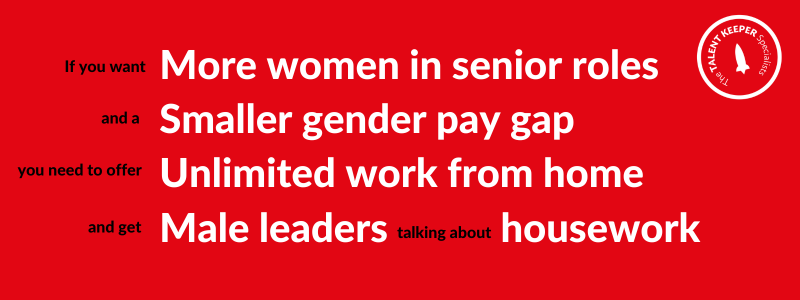How Working From Home Could Close Your Gender Pay Gap (And Why Male Leaders Should Talk About Housework)
Stanford University economics professor Nicholas Bloom thinks remote working is so relevant to today’s knowledge workers he’s co-organising a two-day remote work conference this autumn. He’s the researcher who found working from home led to a 13% uplift in performance among call centre staff at the 16,000-employee, NASDAQ-listed Chinese travel agency, CTrip1.
Working from home is of particular significance to parents and specifically mothers. It’s my contention that if you want more women in senior roles and a smaller or non-existent gender pay gap you need to offer unlimited work from home and encourage male leaders to talk about housework. I haven’t checked but I’m sure Professor Bloom would agree.
Here are the questions I’m answering in this piece
What factors enable women to stay in full time work when they have a young family?
How does WFH compare to a pay increase as a lever for attracting and retaining employees?
Why do people want to work from home?
Why do female employees with young families want to work from home?
How much more unpaid labour are women doing than men?
What’s the story with male leaders talking about housework at work?
Why is Shared Parental Leave relevant to the gender pay gap?
How does WFH contribute to a narrower pay gap?

What factors enable women to stay in full time work when they have a young family?
We polled people in our Instagram community @comebackcommuk about whether they worked full time or part time and were surprised to learn a higher proportion were full time than we expected. Through a series of DMs with people who responded to the poll, we discovered four key things that seem to enable women to stay in full time work when they have a young family:
- An employer who is supportive of working from home.
- An employer who is supportive of compressed hours.
- Wanting to work full time and enjoying your job.
- A supportive partner who shares the load fairly at home.
The nitty gritty of how six mothers make full time work work with a young family is explored in episode 62 of our podcast, COMEBACK COACH. It’s the podcast recommended by HR leaders for people returning to work after maternity and other work breaks.
How does WFH compare to a pay increase as a lever for attracting and retaining employees?
A survey of over 1000 professionals globally in October 2022 and found 63% would “absolutely” look for a new job if they couldn’t continue to work remotely.
This high willingness of professionals to leave their current job for one with remote work shows just how important the freedom to choose where we works is. The pandemic showed us another way of working that helps us blend the totality of our lives and we’re keen to keep it.
The same survey revealed the top factors professionals state they use to evaluate job opportunities and remote working came top:
- Remote work options (84%)
- Salary (81%)
- Work-life balance (79%)
A separate survey in the US 2022 of 4000 people found 63% would prefer better “work-life balance” than higher pay. Specifically, 87% of respondents stated that a remote or hybrid job would or already has improved their work-life balance and 57% stated they would look for a new job if they couldn’t continue to work remotely.
Only 3% of employees want to be in the office 100% of the time (that’s a lot of disgruntled employees at Goldman Sachs) and 65% prefer a 100% remote work arrangement.
Why do people want to work from home?
- To be more productive by having control over their physical environment – sound levels, lighting, temperature, what they wear, the comfort of their chair.
- To be more productive by potentially working asynchronously when you’re working on solo execution stuff – that is, when you’re not collaborating with someone else being able to get the work done when it suits you. This might be making a 6am start on something cognitively complex when you’re fresh and then breakfast and an hour of lifting weights 9-10.30am.
- Cost savings on the commute – no station parking, no costly train.
- Stress-savings on the uncertainty of the commute – no frustration caused by road traffic, cancelled or late running trains, not being able to get a seat and therefore not be able to do the work on your laptop you thought you were going to plough through.
- Ploughing the time otherwise spent on a commute into something that benefits the individual and their organisation such as exercise, making an earlier start on prepping for a meeting or a continuing professional development activity.
- Mental health – in episode 59 of COMEBACK COACH we heard from UX designer, Elena Gorman, how working from home avoids the stress of having to mask how she’s really feeling to colleagues when she’s having a bad mental health day.
- To keep on top of life admin that would otherwise eat into precious downtime at the weekends.
Why do female employees with young families want to work from home?
For all the reasons above and as Caoimhe describes in the video snippet from episode 62 of COMEBACK COACH, to be able to jigsaw piece all the small but significant extra tasks and responsibilities that go with being a parent as well as an adult with a job. Such as:
- Sterilising milk bottles.
- Putting away toddler toys.
- Hanging out the load of “I wet the bed again” laundry.
- Steaming and mashing sweet potato to freeze in weaning pots.
- Putting poo-stained clothes to soak before popping them in the wash.
- Calling the GP to organise vaccinations (whilst unstacking the dishwasher).
Those gaps between meetings – when research shows you need to give your mind a break with something cognitively undemanding if you are to maintain your performance over the day – are perfect opportunities for completing these tasks. If they’re left until the end of a difficult day after a tiresome commute and with children round your ankles who don’t want to go to bed it’s all too easy to feel completely overwhelmed and say “I can’t do this anymore.”
It’s by being able to keep on top of this huge domestic load that mothers with young children can keep working full time in complex, cognitively demanding senior professional roles. My guess is that having a line manager who trusts you and is supportive of working from home reduces the frequency of “giving it all up” fantasies.
Working from home also provides opportunity for extra contact with children because there’s no commute. This increased time together creates good feelings, reduces guilt and the lack of travel time means the morning is less likely to be frantic and involve cross words (which leads to be more performance-inhibiting guilty feelings as you replay what you said to your five year old as you walk home from the school run).
And then there’s the ability to snatch a brief power nap when required. This dose of rest – which most mothers I know don’t do for fear of being literally caught sleeping on the job – is just what sleep-deprived parents need to be able to function properly and maintain sound professional judgement. Until there are sleep pods in offices and using them is not taboo, working from home gives the greatest chance of getting a rest.
How much more unpaid labour are women doing than men?
Women do 60% more unpaid domestic labour than men and unpaid labour has a worse effect on women’s mental health than men2.
In addition and somewhat surprisingly, research by the University of Bath involving data from 6,000 heterosexual couples found that the more women earn in comparison to their partners, the more housework they do. Dr Joanna Syrda of the University’s School of Management who carried out the research explains it as follows:
“It might indicate that traditional gender identity norms – the notion of the ‘male breadwinner’ and its association with masculinity – are so entrenched that couples may try to compensate for a situation where wives earn more than their husbands. I’m interested to find the effect was stronger in married couples than in unmarried cohabiting parents.”
If women are going to stay in the workforce full time once they have children, social norms need to change and there has to be a recalibration of how things work at home. Mothers who work full time should not be carrying the huge and unequal load at home compared to their partners. It has health implications, it causes marital resentment and there’s an implication for what our children they think is normal for men and women to do.
In my book “Mothers Work!” I offer the reader an important question to put to their partner or spouse as they, the reader, returns to work: “Now that we are about to become a dual earning family, how are we going to share the load?” This is something I reiterate in episode 40: 7 questions for a smooth and successful return to work from maternity leave and other work breaks.
What’s the story with male leaders talking about housework at work?
Even the most committed business leaders to gender equality in the workplace can’t tell their male employees to do more housework. It’s an overreach. But you can talk about the domestic duties you do at home; the ways in which you share the mental load; actively care for your children and the ways in which you support your partner’s career. If you’re not doing these things, when will you start? By talking about what you do at home with other men in your organisation, you signal that that’s what men in positions of professional power do. You normalise senior men being active at home.
Why is Shared Parental Leave relevant to the gender pay gap?
On this note, I recently had a conversation with Times journalist and The Equal Parent author Paul Morgan-Bentley and his husband Robin about parental equality. They had their son Solly through surrogacy and they each took exactly the same number of days shared parental leave. Shared Parental Leave is a significant lever for closing the gender pay gap because it begins to level the playing field between men and women when they become parents (it also helps close the gender pensions gap). It reduces the likelihood of maternity discrimination too because if both genders are equally likely to take leave there’s no advantage in employing a man of a certain age instead of a woman.
As an aside, my personal view is that Shared Parental Leave was a doomed Government policy and fathers need a use-it-or-lose-it portion of parental leave equal to that of mothers. But that’s another story I’ve written elsewhere.
How does WFH contribute to a narrower gender pay gap?
In many organisations with a gender pay gap in favour of men, the problem is due to the far greater numbers of men in the highest paid jobs. Keeping women in full time work and supporting their career aspirations when they become mothers (and most women do become mothers so it’s vital we recognise this) is vital. Only in high trust environments where women can work from home – for all the reasons described above – without penalty and where male colleagues are taking Shared Parental Leave and sharing the load at home will women stay and make those tops jobs.
Your other option is simply to pay mothers for their unpaid labour at home.
References and Resources
1Call centre employees who volunteered to WFH were randomly assigned to work from home or in the office for 9 months. Home working led to a 13% performance increase, of which about 9% was from working more minutes per shift (fewer breaks and sick-days) and 4% from more calls per minute (attributed to a quieter working environment). Home workers also reported improved work satisfaction and experienced less turnover, but their promotion rate conditional on performance fell. Due to the success of the experiment, CTrip rolled-out the option to WFH to the whole firm and allowed the experimental employees to re-select between the home or office. Interestingly, over half of them switched, which led to the gains from WFH almost doubling to 22%. This highlights the benefits of learning and selection effects when adopting modern management practices like WFH.
2A review published in The Lancet Public Health by a team from the university of Melbourne explored the impact of unpaid labour on mental health. As part of their review they looked at 9 studies that specifically explored housework as a form of unpaid labour, and of these, six reported a relationship between increased housework and poor mental health in women. For men, only three of the studies found a link for increased housework and poorer mental health. The team point out in their paper that the difference might be due to men receiving praise for doing things like childcare and housework whereas women do not. They concluded that policies need to be in place to better spread the division of labour between mothers and fathers such as more equal parental leave, flexible working arrangements and promotion of paternal involvement in childcare.




Leave a Reply
Want to join the discussion?Feel free to contribute!